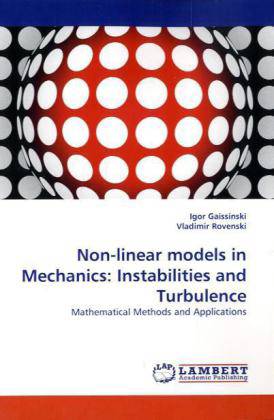
- Afhalen na 1 uur in een winkel met voorraad
- Gratis thuislevering in België vanaf € 30
- Ruim aanbod met 7 miljoen producten
- Afhalen na 1 uur in een winkel met voorraad
- Gratis thuislevering in België vanaf € 30
- Ruim aanbod met 7 miljoen producten
Zoeken
Non-linear models in Mechanics: Instabilities and Turbulence
Mathematical Methods and Applications
Igor Gaissinski, Vladimir Rovenski
Paperback | Engels
€ 112,45
+ 224 punten
Omschrijving
Nonlinear phenomena and instabilities arise in all fields of physics, chemistry, biology, and engineering. The book consists of six chapters. Chapter 1 contains preliminary topics from analysis: elements of set theory, measure theory, integration theory, asymptotic expansions, continued fractions and Pad'e approximations. Chapters 2 and 3 are devoted to basic and advanced methods of ODE's and their visualization: attractors, fractals, bifurcations, chaos, and elements of stability theory. Chapter 4 studies analytical and geometrical aspects of perturbation theory and contains many examples. Chapter 5 represents the basic knowledge in turbulence theory and introduces to Richardson-Kolmogorov concept, deals with bifurcations in Kuramoto-Sivashinsky equation, and develops multifractal and hierarchical (shell) models of turbulence. The main hydrodynamic instabilities (Rayleigh-Taylor, Kelvin-Helmholtz, and Richtmyer-Meshkov) are studied in Chapter 6. The book contains theoretical and practical materials, examples and exercises and can be recommended to students and specialists of mathematics and physics, chemistry, biology and engineering.
Specificaties
Betrokkenen
- Auteur(s):
- Uitgeverij:
Inhoud
- Aantal bladzijden:
- 700
- Taal:
- Engels
Eigenschappen
- Productcode (EAN):
- 9783843366557
- Verschijningsdatum:
- 5/11/2010
- Uitvoering:
- Paperback
- Afmetingen:
- 152 mm x 229 mm
- Gewicht:
- 1012 g

Alleen bij Standaard Boekhandel
+ 224 punten op je klantenkaart van Standaard Boekhandel
Beoordelingen
We publiceren alleen reviews die voldoen aan de voorwaarden voor reviews. Bekijk onze voorwaarden voor reviews.








